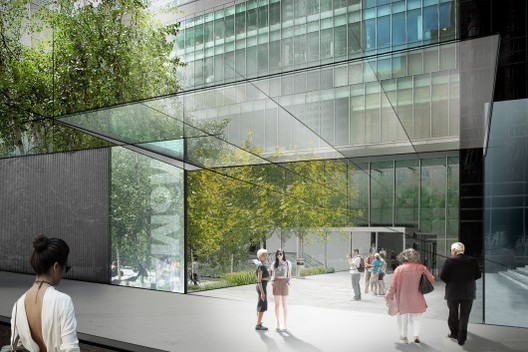
Yesterday, Glenn Lowry, director of the Museum of Modern Art (MoMA), and Elizabeth Diller, principal of Diller Scofidio + Renfro, presented their plans for the MoMA expansion to an audience in New York City, insisting - once again - that they require the demolition of the American Folk Art Museum.
The presentation was part of a larger event, "A Conversation on the Museum of Modern Art’s Plan for Expansion," presented by The Architectural League, the Municipal Art Society, and the American Institute of Architects New York Chapter. After Lowry and Diller reiterated their case, a panel of experts - including the editor of Architectural Record, Cathleen McGuigan, and critic Nicolai Ouroussoff - gave their opinions on the subject (some panelists spousing particularly anti-MoMA sentiments). ArchDaily was there to catch the conversation; read on after the break for the highlights.
.jpg?1391003841)
While Elizabeth Diller's presentation was very well-received, the real fun began when the panel - moderated by the director of the Cranbrook Academy, Reed Kroloff - began to give their two cents.
While Nicolai Ouroussoff and Jorge Otero-Pailos, architect and preservation theorist, kept their comments fairly strictly in the realm of theory, the other panelists entered the fray with their opinions. Stephen Rustow, principal of design firm Museoplan, rejected Lowry and Diller's claim that demolition was necessary, citing MoMA's long history of preserving existing buildings with every expansion (indeed, Philip Johnson, Pelli, and Taniguchi were all tasked with preservation). Cathleen McGuigan suggested that there was still time for MoMA to "Stop and re-consider the demolition."
Architectural consultant and writer Karen Stein was the most vehement opposer of the plans, saying that the facts seemed contradictory (even saying that the circulation issues could be accounted for). Stein pointed out that the mission of the Department of Architecture & Design of the MoMA is completely at odds with this demolition, finishing with the statement: "I expect something better from MoMA."
.jpg?1391003841)
During the Q&A, Lowry offered a kind of defense; answering the question of whether or not he considers architecture to be art, he emphasized that architecture, unlike art, is entirely linked to function: "You don't collect buildings and there's a reason for that." By the end of the night, he and Diller seemed to have swayed the audience to their side.
Ultimately, however, public opinion will make very little difference. Lowry insisted that while there was room for "some adjustments": "The decision has been made." The American Folk Art Museum's days are numbered.
And now for some reactions to the #MoMAConvo from the twitterverse:
#MoMAconvo Demolition of Folk makes no sense because it's based on an expansion plan that can't fix problems but doubles down on failure.
— Michael Kimmelman (@kimmelman) January 29, 2014 #momaconvo Diller: museum directors always want horizontality. So do mall operators.
— Justin Davidson (@JDavidsonNYC) January 29, 2014 #MoMAConvo Karen Stein: "if WalMart owned the folk art museum I would expect them to tear it down. But not MoMA."
— Paul Goldberger (@paulgoldberger) January 29, 2014 #momaconvo Karen Stein: once you make circulation the top priority, removing AFAM is inevitable. Prob is assumption
— Justin Davidson (@JDavidsonNYC) January 29, 2014 Ouroussoff sees the lack of public participation in the conversation as "the dark cloud hanging over this" #MoMAconvo
— CenterForArch (@CenterForArch) January 29, 2014 KEY POINT MT@wrocktext The public has a right to the conversation since public money is part of AFAM and MoMA's funding #momaconvo #folkmoma
— #FolkMoMA (@FolkMoMA) January 29, 2014 #MoMAconvo Whatever happens w folk art museum it is meaningful, even moving, to see 100s of people at a forum bc they care about a building
— Paul Goldberger (@paulgoldberger) January 29, 2014 
